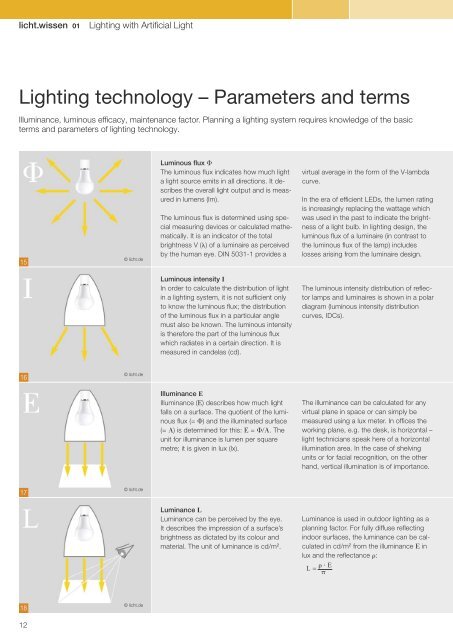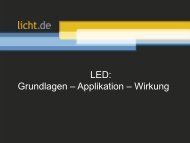licht.wissen No. 01 "Lighting with Artificial Light"
Booklet 1 is intended for all those who want to delve into the topic of light and lighting or wish to familiarize themselves with the basics of lighting technology. It also helps to make a decision in the field of lighting. Free Download at www.licht.de/en
Booklet 1 is intended for all those who want to delve into the topic of light and lighting or wish to familiarize themselves with the basics of lighting technology. It also helps to make a decision in the field of lighting. Free Download at www.licht.de/en
Create successful ePaper yourself
Turn your PDF publications into a flip-book with our unique Google optimized e-Paper software.
<strong>licht</strong>.<strong>wissen</strong> <strong>01</strong><br />
<strong>Lighting</strong> <strong>with</strong> <strong>Artificial</strong> Light<br />
<strong>Lighting</strong> technology – Parameters and terms<br />
Illuminance, luminous efficacy, maintenance factor. Planning a lighting system requires knowledge of the basic<br />
terms and parameters of lighting technology.<br />
15<br />
© <strong>licht</strong>.de<br />
Luminous flux <br />
The luminous flux indicates how much light<br />
a light source emits in all directions. It describes<br />
the overall light output and is measured<br />
in lumens (lm).<br />
The luminous flux is determined using special<br />
measuring devices or calculated mathematically.<br />
It is an indicator of the total<br />
brightness V () of a luminaire as perceived<br />
by the human eye. DIN 5031-1 provides a<br />
virtual average in the form of the V-lambda<br />
curve.<br />
In the era of efficient LEDs, the lumen rating<br />
is increasingly replacing the wattage which<br />
was used in the past to indicate the brightness<br />
of a light bulb. In lighting design, the<br />
luminous flux of a luminaire (in contrast to<br />
the luminous flux of the lamp) includes<br />
losses arising from the luminaire design.<br />
Luminous intensity I<br />
In order to calculate the distribution of light<br />
in a lighting system, it is not sufficient only<br />
to know the luminous flux; the distribution<br />
of the luminous flux in a particular angle<br />
must also be known. The luminous intensity<br />
is therefore the part of the luminous flux<br />
which radiates in a certain direction. It is<br />
measured in candelas (cd).<br />
The luminous intensity distribution of reflector<br />
lamps and luminaires is shown in a polar<br />
diagram (luminous intensity distribution<br />
curves, IDCs).<br />
16<br />
© <strong>licht</strong>.de<br />
Illuminance E<br />
Illuminance () describes how much light<br />
falls on a surface. The quotient of the luminous<br />
flux (= ) and the illuminated surface<br />
(= ) is determined for this: = /. The<br />
unit for illuminance is lumen per square<br />
metre; it is given in lux (lx).<br />
The illuminance can be calculated for any<br />
virtual plane in space or can simply be<br />
measured using a lux meter. In offices the<br />
working plane, e.g. the desk, is horizontal –<br />
light technicians speak here of a horizontal<br />
illumination area. In the case of shelving<br />
units or for facial recognition, on the other<br />
hand, vertical illumination is of importance.<br />
17<br />
© <strong>licht</strong>.de<br />
Luminance L<br />
Luminance can be perceived by the eye.<br />
It describes the impression of a surface’s<br />
brightness as dictated by its colour and<br />
material. The unit of luminance is cd/m 2 .<br />
Luminance is used in outdoor lighting as a<br />
planning factor. For fully diffuse reflecting<br />
indoor surfaces, the luminance can be calculated<br />
in cd/m 2 from the illuminance in<br />
lux and the reflectance :<br />
L = · E<br />
<br />
18<br />
© <strong>licht</strong>.de<br />
12

















